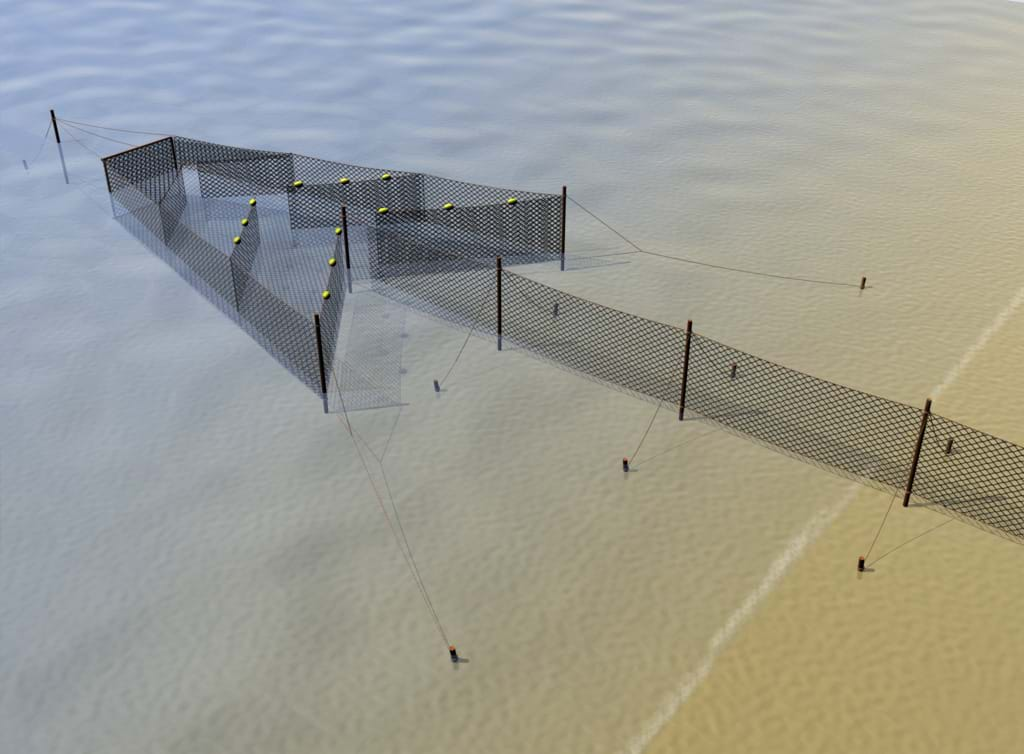Bag net
Summary
A bag net has a long vertical wall of netting, often several hundred metres long, running at right angles to the shoreline that is intended to interrupt the natural swim of the fish and direct them along it away from the shore and into a series of traps.

Environmental impact
Generally an environmental method of targeting fish that are close inshore. It is usually a seasonal fishery when the target species are migrating or known to the moving close along the shorelines at certain times of the year. Therefore by-catch is minimised by not having the gear in the water all the year round.
The size of species caught can be easily regulated by specifying a minimum mesh size that can be used. there is minimal seabed impact as the gear is fixed and does not move across the seabed at all. There will be some intertidal seabed disturbance when the gear is initially set out but this is in an already highly mobile area of the seabed.
The bag net has however historically been blamed as having a contribution to the decreasing numbers of salmon and sea trout entering the UK river system. It has been claimed that along with bag nets that the gear has been too effective in targeting salmon and sea trout as they approach the river mouths.
Other information
In the UK this used to be a traditional method of fishing for salmon and sea trout as they head for the river mouths to swim up the rivers to spawn. This fishing method has died out in most areas but in some places there are still the remnants of the poles from the bag nets on the shore.
Many migratory fish such as salmon and sea trout have a tendency to swim parallel to the shoreline as they move between feeding areas and spawning grounds. The bag net is designed to interrupt this swim line. When the fish come up against the 'wall' of netting they will turn and swim along it. If they swim one way they will come up against the shoreline so turn and follow the netting seawards. as they swim in this direction they will encounter the 'trap' section of the bag net.
These traps are similar to other fish traps in that the fish are easily directed into the trap but the escape is hard to find. The easiest found exit from the first trap is into the second trap, and then on into the third trap where the fish should be held until the net is emptied.
Usually this gear is inspected for fish as the tide recedes and leaves shallow water in the final trap section. The fish will be scooped out using a larger version of and anglers landing net. On some of the larger versions of this gear the final trap can be sub divided by moving sections of netting or the netting floor lifted to trap the fish in a smaller section to make it easier to scoop them out.
Although there is not much of this type of fishing in the UK today there are many examples of this style of gear employed in the estuaries and shorelines in other countries. These are nets that are designed to be fixed to a beach or seabed to catch fish and guide them into a trap section. They work on a similar principle to the entrances to other pots and traps but on a larger scale. They are often used to capture fish as they migrate along a shoreline or up an estuary. Examples of these can be seen in some shorelines in Scotland targeting migrating salmon and sea trout. They have a long vertical wall of netting, often several hundred metres long, running at right angles to the shoreline that is intended to interrupt the natural swim of the fish and direct them along it away from the shore and into a series of traps. Just as in pots these all have an easy entrance for the fish but a difficult exit so the fish are retained. There are two main types used in Scotland bag nets that are set in deeper water just offshore and fixed with anchors and stake nets that are set on stakes fixed into the beach but both gears work on the same principle.
Gear classification
Possible bycatch
-
- Bass
- Dab
- Flounder